Intranasal Administration of Cold-Adapted Live-Attenuated Eurasian Avian-like H1N1 Vaccine Candidate Confers Protection Against Different-Lineage H1N1 Viruses in Mice
Abstract
1. Introduction
2. Materials and Methods
2.1. Viruses and Cells
2.2. Cold Adaptation of H1N1 Influenza Virus
2.3. Cold Adaptation and Temperature Sensitivity Phenotype Analysis of the GX18ca Virus
2.4. Multiple-Step Growth Kinetics of GX18ca and GX18 in MDCK Cells
2.5. Replication of H1N1 Influenza Viruses GX18ca and GX18 in Mice
2.6. Evaluation of Immunogenicity of the GX18ca Vaccine Candidate in Mice
2.7. Evaluation of the Efficacy of the GX18ca Virus Vaccine Candidate in Mice
2.8. Statistical Analysis
3. Results
3.1. Generation of a Cold-Adapted and Temperature-Sensitive H1N1 Swine Influenza Virus GX18ca
3.2. Attenuation Confirmation of the Live-Attenuated GX18ca Vaccine Candidate in Mice
3.3. GX18ca Vaccine Candidate Elicits Anti-H1 Influenza Virus Cellular Immunity in Mice
3.4. GX18ca Vaccine Candidate Elicits Cross-Reactive Mucosal SIgA Against H1 Influenza Viruses
3.5. HI and NT Antibody Titers Induced by GX18ca Vaccine Candidate in Mice
3.6. IgG Antibody Responses Induced by GX18ca Vaccine Candidate in Mice
3.7. Protective Efficacy Against Homologous and Heterologous Challenges
4. Discussion
5. Conclusions
Author Contributions
Funding
Institutional Review Board Statement
Informed Consent Statement
Data Availability Statement
Conflicts of Interest
References
- Vijaykrishna, D.; Poon, L.L.; Zhu, H.C.; Ma, S.K.; Li, O.T.; Cheung, C.L.; Smith, G.J.; Peiris, J.S.; Guan, Y. Reassortment of pandemic H1N1/2009 influenza A virus in swine. Science 2010, 328, 1529. [Google Scholar] [CrossRef]
- Henritzi, D.; Petric, P.P.; Lewis, N.S.; Graaf, A.; Pessia, A.; Starick, E.; Breithaupt, A.; Strebelow, G.; Luttermann, C.; Parker, L.M.K.; et al. Surveillance of European Domestic Pig Populations Identifies an Emerging Reservoir of Potentially Zoonotic Swine Influenza A Viruses. Cell Host Microbe 2020, 28, 614–627.e6. [Google Scholar] [CrossRef]
- Ducatez, M.F.; Hause, B.; Stigger-Rosser, E.; Darnell, D.; Corzo, C.; Juleen, K.; Simonson, R.; Brockwell-Staats, C.; Rubrum, A.; Wang, D.; et al. Multiple reassortment between pandemic (H1N1) 2009 and endemic influenza viruses in pigs, United States. Emerg. Infect. Dis. 2011, 17, 1624–1629. [Google Scholar] [CrossRef] [PubMed]
- Zeller, M.A.; Ma, J.; Wong, F.Y.; Tum, S.; Hidano, A.; Holt, H.; Chhay, T.; Sorn, S.; Koeut, D.; Seng, B.; et al. The genomic landscape of swine influenza A viruses in Southeast Asia. Proc. Natl. Acad. Sci. USA 2023, 120, e2301926120. [Google Scholar] [CrossRef]
- Yang, H.; Chen, Y.; Qiao, C.; He, X.; Zhou, H.; Sun, Y.; Yin, H.; Meng, S.; Liu, L.; Zhang, Q.; et al. Prevalence, genetics, and transmissibility in ferrets of Eurasian avian-like H1N1 swine influenza viruses. Proc. Natl. Acad. Sci. USA 2016, 113, 392–397. [Google Scholar] [CrossRef]
- Meng, F.; Chen, Y.; Song, Z.C.; Zhong, Q.; Zhang, Y.J.; Qiao, C.L.; Yan, C.; Kong, H.; Liu, L.; Li, C.; et al. Continued evolution of the Eurasian avian-like H1N1 swine influenza viruses in China. Sci. China-Life Sci. 2023, 66, 269–282. [Google Scholar] [CrossRef] [PubMed]
- Wang, Z.; Chen, Y.; Chen, H.; Meng, F.; Tao, S.; Ma, S.; Qiao, C.; Chen, H.; Yang, H. A single amino acid at position 158 in haemagglutinin affects the antigenic property of Eurasian avian-like H1N1 swine influenza viruses. Transbound. Emerg. Dis. 2022, 69, e236–e243. [Google Scholar] [CrossRef] [PubMed]
- Ang, J.C.; Wang, B.; Wang, J.J.F.; Zeng, P.Y.F.; Krammer, F.; Ward, B.J.; Russell, M.L.; Loeb, M.; Miller, M.S. Comparative Immunogenicity of the 2014–2015 Northern Hemisphere Trivalent IIV and LAIV Against Influenza A Viruses in Children. Vaccines 2019, 7, 87. [Google Scholar] [CrossRef]
- Li, L.; Shi, N.; Xu, N.; Wang, H.; Zhao, H.; Xu, H.; Liu, D.; Zhang, Z.; Li, S.; Zhang, J.; et al. Safety and Viral Shedding of Live Attenuated Influenza Vaccine (LAIV) in Chinese Healthy Juveniles and Adults: A Phase I Randomized, Double-Blind, Placebo-Controlled Study. Vaccines 2022, 10, 1796. [Google Scholar] [CrossRef]
- Roy, S.; Williams, C.M.; Wijesundara, D.K.; Furuya, Y. Impact of Pre-Existing Immunity to Influenza on Live-Attenuated Influenza Vaccine (LAIV) Immunogenicity. Vaccines 2020, 8, 683. [Google Scholar] [CrossRef]
- Vincent, A.L.; Perez, D.R.; Rajao, D.; Anderson, T.K.; Abente, E.J.; Walia, R.R.; Lewis, N.S. Influenza A virus vaccines for swine. Vet. Microbiol. 2017, 206, 35–44. [Google Scholar] [CrossRef] [PubMed]
- Chen, H.; Matsuoka, Y.; Swayne, D.; Chen, Q.; Cox, N.J.; Murphy, B.R.; Subbarao, K. Generation and characterization of a cold-adapted influenza A H9N2 reassortant as a live pandemic influenza virus vaccine candidate. Vaccine 2003, 21, 4430–4436. [Google Scholar] [CrossRef] [PubMed]
- Wang, Z.; Yang, H.; Chen, Y.; Tao, S.; Liu, L.; Kong, H.; Ma, S.; Meng, F.; Suzuki, Y.; Qiao, C.; et al. A Single-Amino-Acid Substitution at Position 225 in Hemagglutinin Alters the Transmissibility of Eurasian Avian-Like H1N1 Swine Influenza Virus in Guinea Pigs. J. Virol. 2017, 91, e00800-17. [Google Scholar] [CrossRef]
- Shi, J.; Wen, Z.; Guo, J.; Zhang, Y.; Deng, G.; Shu, Y.; Wang, D.; Jiang, Y.; Kawaoka, Y.; Bu, Z.; et al. Protective efficacy of an H1N1 cold-adapted live vaccine against the 2009 pandemic H1N1, seasonal H1N1, and H5N1 influenza viruses in mice. Antivir. Res. 2012, 93, 346–353. [Google Scholar] [CrossRef]
- Yang, W.; Yin, X.; Guan, L.; Li, M.; Ma, S.; Shi, J.; Deng, G.; Suzuki, Y.; Chen, H. A live attenuated vaccine prevents replication and transmission of H7N9 highly pathogenic influenza viruses in mammals. Emerg. Microbes Infect. 2018, 7, 153. [Google Scholar] [CrossRef] [PubMed]
- Yang, H.; Qiao, C.; Tang, X.; Chen, Y.; Xin, X.; Chen, H. Human infection from avian-like influenza A (H1N1) viruses in pigs, China. Emerg. Infect. Dis. 2012, 18, 1144–1146. [Google Scholar] [CrossRef]
- Qiao, C.; Liu, L.; Yang, H.; Chen, Y.; Xu, H.; Chen, H. Novel triple reassortant H1N2 influenza viruses bearing six internal genes of the pandemic 2009/H1N1 influenza virus were detected in pigs in China. J. Clin. Virol. 2014, 61, 529–534. [Google Scholar] [CrossRef]
- Meng, F.; Yang, H.; Qu, Z.; Chen, Y.; Zhang, Y.; Zhang, Y.; Liu, L.; Zeng, X.; Li, C.; Kawaoka, Y.; et al. A Eurasian avian-like H1N1 swine influenza reassortant virus became pathogenic and highly transmissible due to mutations in its PA gene. Proc. Natl. Acad. Sci. USA 2022, 119, e2203919119. [Google Scholar] [CrossRef]
- Yang, H.; Chen, Y.; Shi, J.; Guo, J.; Xin, X.; Zhang, J.; Wang, D.; Shu, Y.; Qiao, C.; Chen, H. Reassortant H1N1 influenza virus vaccines protect pigs against pandemic H1N1 influenza virus and H1N2 swine influenza virus challenge. Vet. Microbiol. 2011, 152, 229–234. [Google Scholar] [CrossRef]
- Subbarao, K. Live Attenuated Cold-Adapted Influenza Vaccines. Cold Spring Harb. Perspect. Med. 2021, 11, a038653. [Google Scholar] [CrossRef]
- Caspard, H.; Heikkinen, T.; Belshe, R.B.; Ambrose, C.S. A systematic review of the efficacy of live attenuated influenza vaccine upon revaccination of children. Hum. Vaccines Immunother. 2016, 12, 1721–1727. [Google Scholar] [CrossRef] [PubMed][Green Version]
- Lu, J.; Duan, X.; Zhao, W.; Wang, J.; Wang, H.; Zhou, K.; Fang, M. Aged Mice are More Resistant to Influenza Virus Infection due to Reduced Inflammation and Lung Pathology. Aging Dis. 2018, 9, 358–373. [Google Scholar] [CrossRef] [PubMed]
- Halloran, M.E.; Piedra, P.A.; Longini, I.M.; Gaglani, M.J., Jr.; Schmotzer, B.; Fewlass, C.; Herschler, G.B.; Glezen, W.P. Efficacy of trivalent, cold-adapted, influenza virus vaccine against influenza A (Fujian), a drift variant, during 2003–2004. Vaccine 2007, 25, 4038–4045. [Google Scholar] [CrossRef]
- Romanova, J.R.; Tannock, G.A.; Alexandrova, G.I. Protective responses in mice to vaccination with multiply administered cold-adapted influenza vaccine reassortants and wild-type viruses. Vaccine 1997, 15, 653–658. [Google Scholar] [CrossRef] [PubMed]


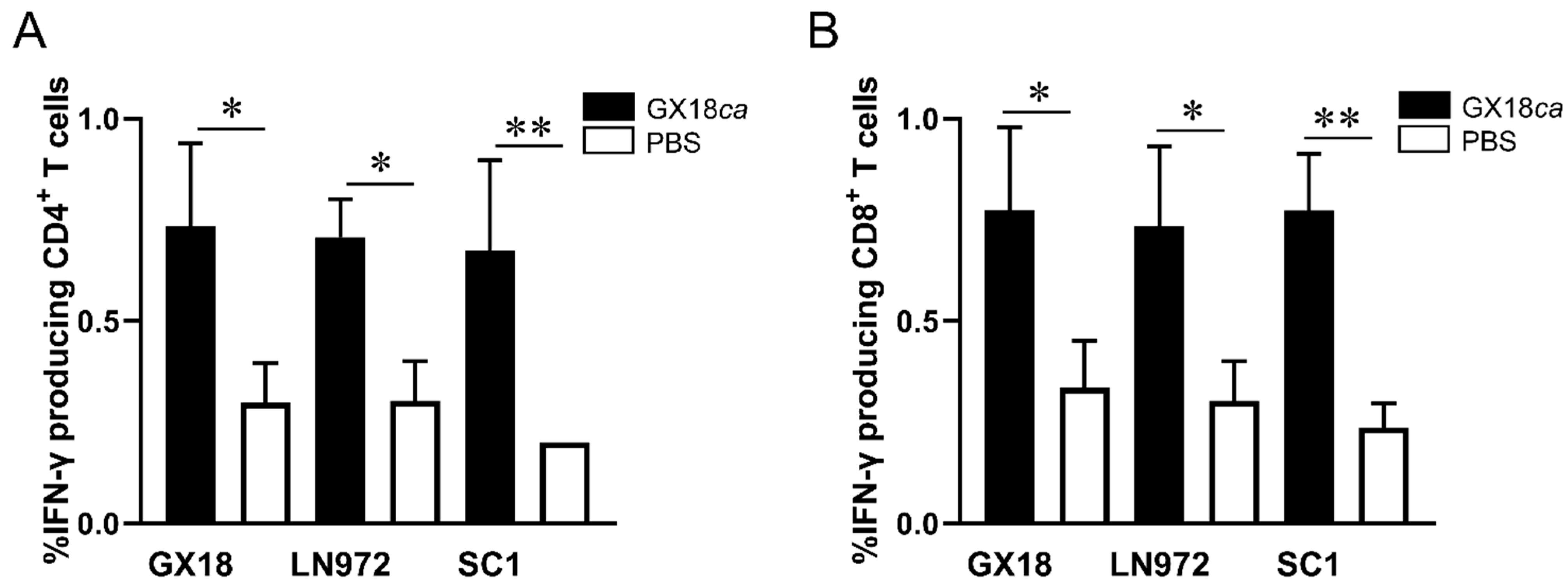
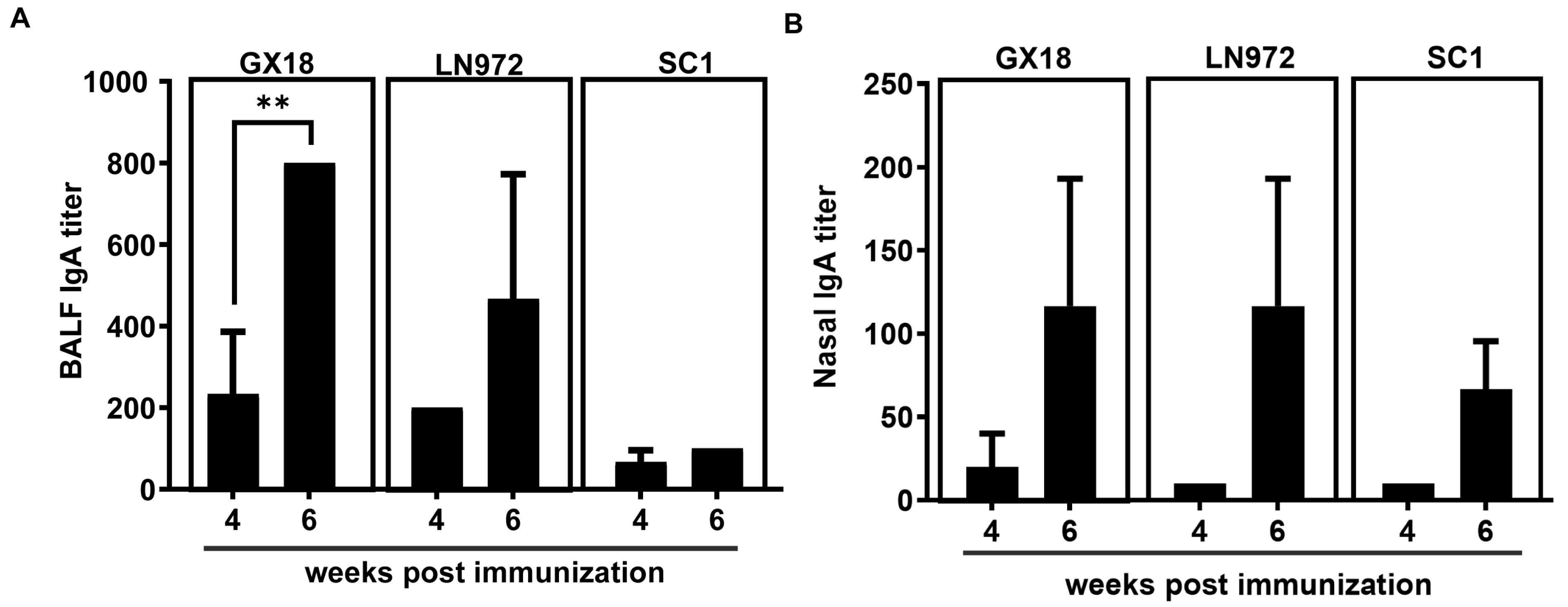
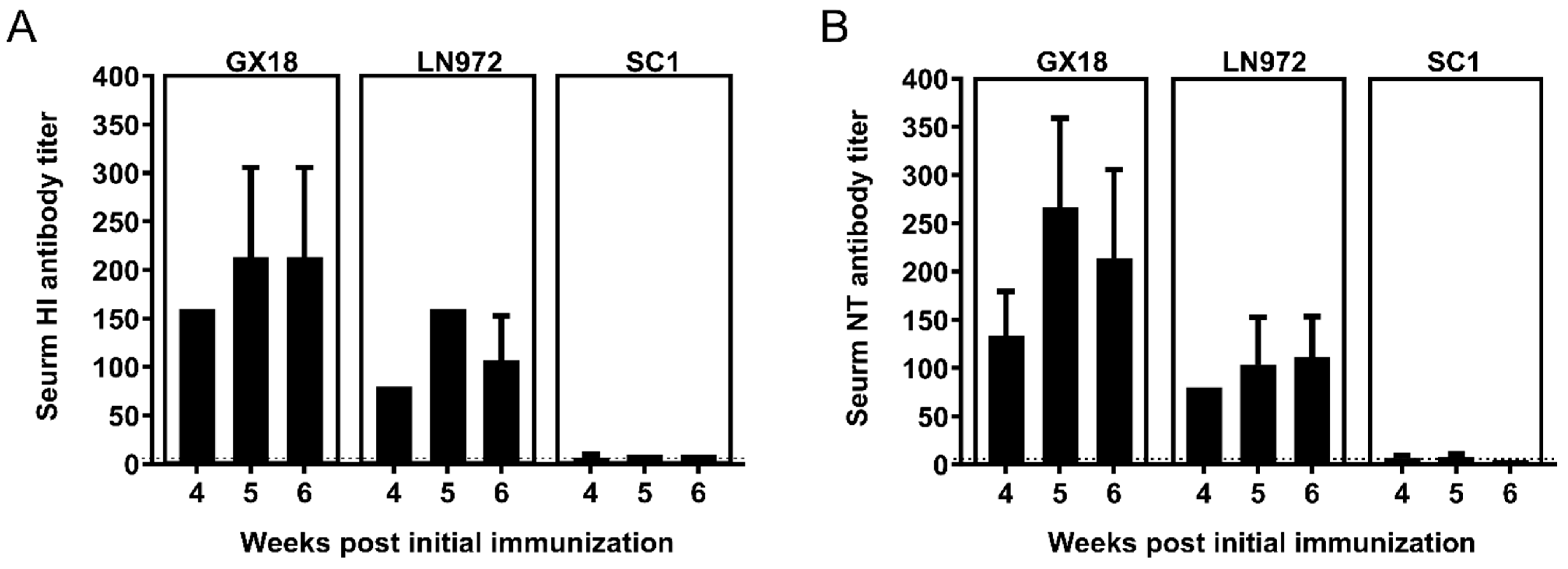
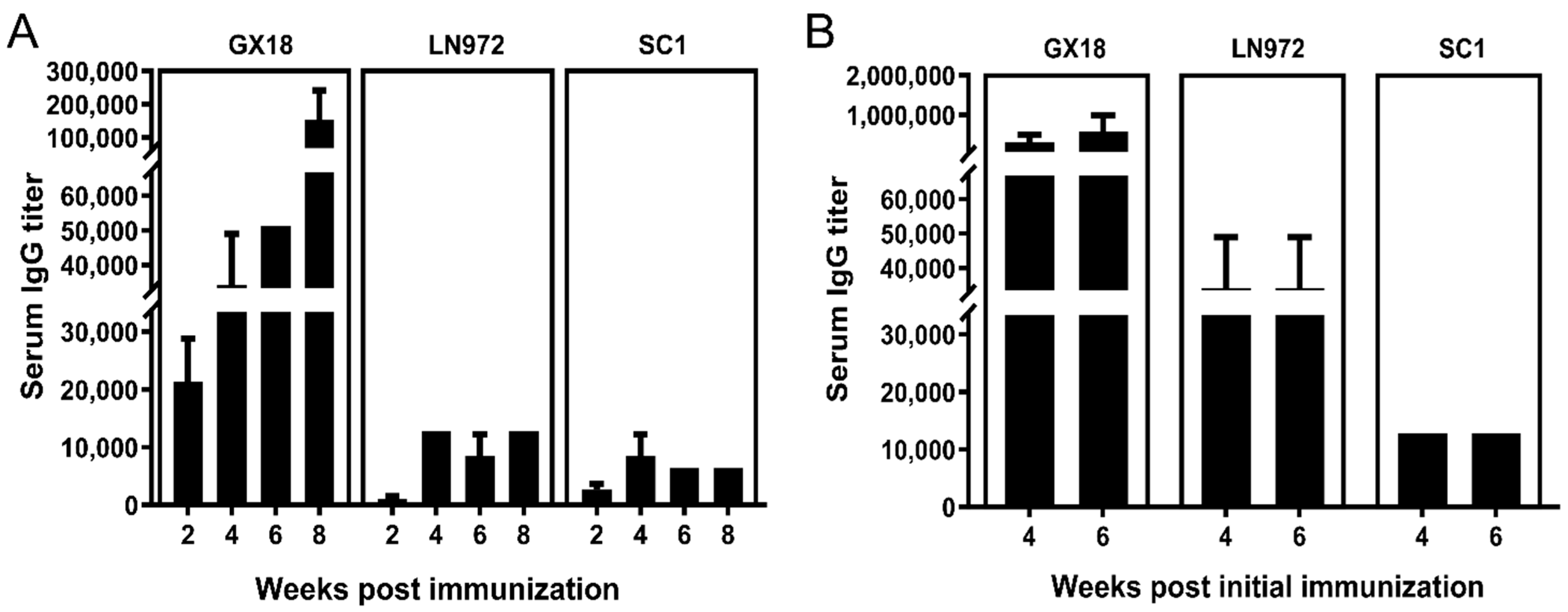
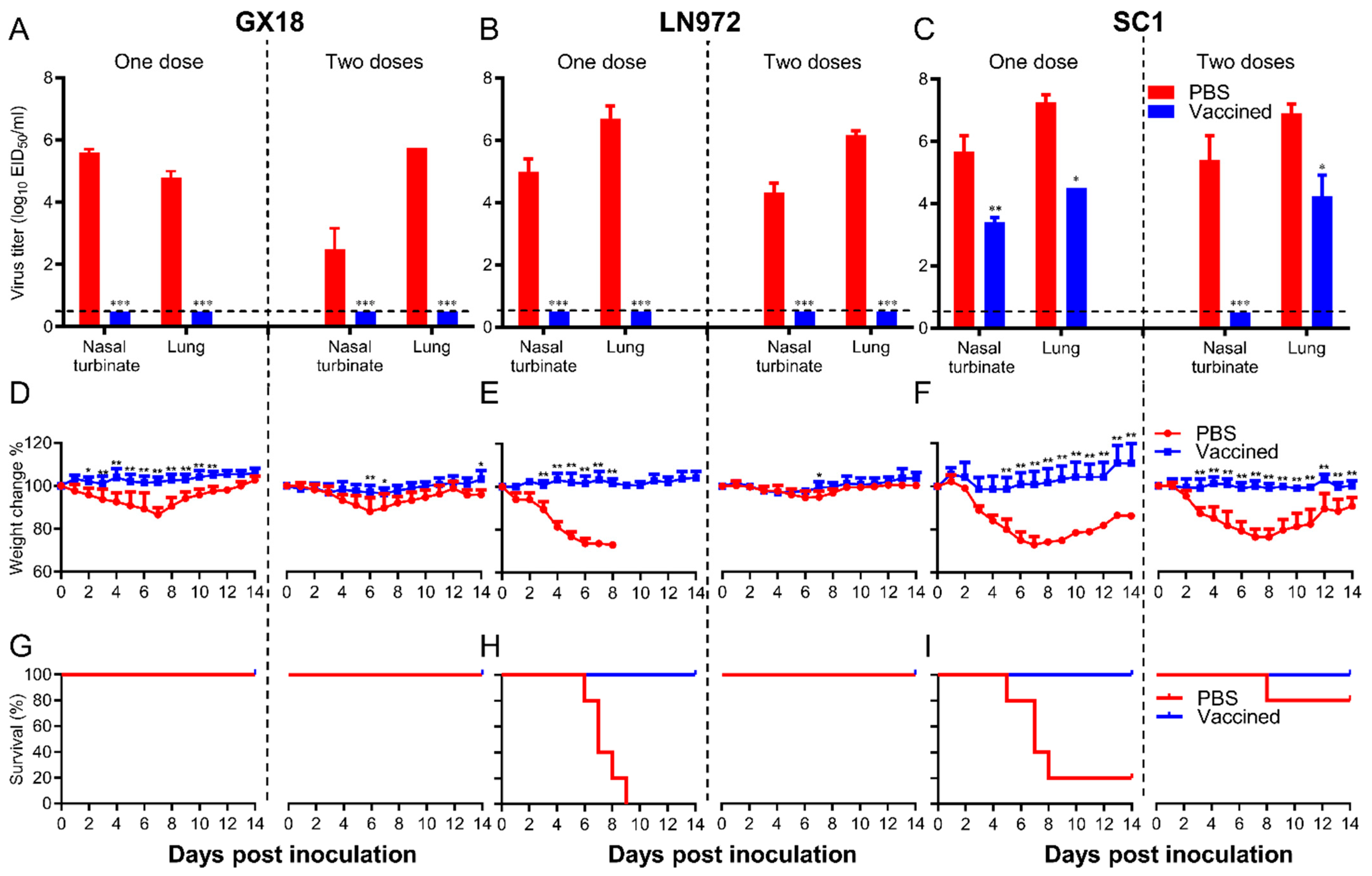
Disclaimer/Publisher’s Note: The statements, opinions and data contained in all publications are solely those of the individual author(s) and contributor(s) and not of MDPI and/or the editor(s). MDPI and/or the editor(s) disclaim responsibility for any injury to people or property resulting from any ideas, methods, instructions or products referred to in the content. |
© 2025 by the authors. Licensee MDPI, Basel, Switzerland. This article is an open access article distributed under the terms and conditions of the Creative Commons Attribution (CC BY) license (https://creativecommons.org/licenses/by/4.0/).
Share and Cite
Zhong, Q.; Song, Z.; Meng, F.; Wang, Y.; Zhang, Y.; Feng, Z.; Zhang, Y.; Zhai, Y.; Chen, Y.; Qiao, C.; et al. Intranasal Administration of Cold-Adapted Live-Attenuated Eurasian Avian-like H1N1 Vaccine Candidate Confers Protection Against Different-Lineage H1N1 Viruses in Mice. Vaccines 2025, 13, 596. https://doi.org/10.3390/vaccines13060596
Zhong Q, Song Z, Meng F, Wang Y, Zhang Y, Feng Z, Zhang Y, Zhai Y, Chen Y, Qiao C, et al. Intranasal Administration of Cold-Adapted Live-Attenuated Eurasian Avian-like H1N1 Vaccine Candidate Confers Protection Against Different-Lineage H1N1 Viruses in Mice. Vaccines. 2025; 13(6):596. https://doi.org/10.3390/vaccines13060596
Chicago/Turabian StyleZhong, Qiu, Zuchen Song, Fei Meng, Yanwen Wang, Yijie Zhang, Zijian Feng, Yali Zhang, Yujia Zhai, Yan Chen, Chuanling Qiao, and et al. 2025. "Intranasal Administration of Cold-Adapted Live-Attenuated Eurasian Avian-like H1N1 Vaccine Candidate Confers Protection Against Different-Lineage H1N1 Viruses in Mice" Vaccines 13, no. 6: 596. https://doi.org/10.3390/vaccines13060596
APA StyleZhong, Q., Song, Z., Meng, F., Wang, Y., Zhang, Y., Feng, Z., Zhang, Y., Zhai, Y., Chen, Y., Qiao, C., Chen, H., & Yang, H. (2025). Intranasal Administration of Cold-Adapted Live-Attenuated Eurasian Avian-like H1N1 Vaccine Candidate Confers Protection Against Different-Lineage H1N1 Viruses in Mice. Vaccines, 13(6), 596. https://doi.org/10.3390/vaccines13060596






